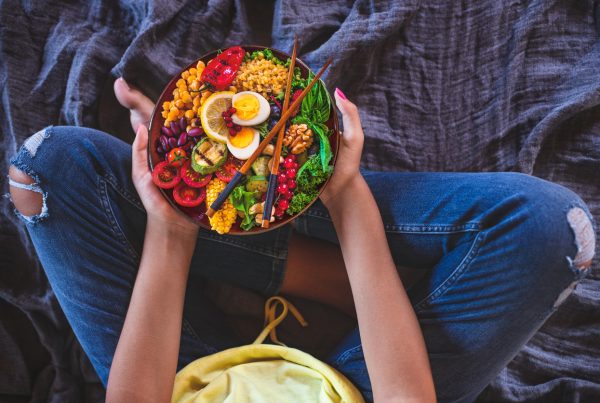In part one, Dr Linia Patel introduced the idea of the latest trend – food combining – and talked about its history, the rules and the science behind the claims. In part two, Linia delves deeper into the science and gives you her clinical verdict of the trend and practical ways to make food combinations work for you.
Although there is not much direct research looking at food combining, basic biochemistry is what nutrition experts lean on to understand if this trend actually holds up to all its claims. Let’s take a closer look:
-
Can you ever really separate out macronutrients in food?
The reality is that a food is rarely all just one macronutrient. It is usually a combination. Take lentils, for example. They are about 60-70% carbohydrates and 30-40% protein. Or brown rice. It is about 80% carbohydrate, yet it contains about 7% fat and 10% protein. In addition, although meat is considered a protein food, even lean meat contains some fat. Therefore, as many foods contain a combination of carbohydrates, fat and protein, your digestive tract is always prepared to digest a mixed meal. To prove this, when you look at the physiology of digestion, when food enters your stomach, gastric acids are released along with the enzymes lipase (breaks down fat) and pepsin (breaks down protein). Next, your food moves to your small intestine where the gastric acids from the stomach are neutralised and your intestine is flooded with a combination of enzymes that break down proteins, fats and carbohydrates.
-
Food fermentation in the stomach.
Although a common belief of improper food combining is that food ferments in our stomach, the reality is that your stomach is a very acidic environment that almost no bacteria can survive in, hence fermentation does not happen in the stomach. Fermentation does occur in the large intestine, where your gut bacteria thrive on it. When we eat foods containing prebiotics, your gut bacteria have a party.Prebiotics are nutrients that, when fermented by the good bacteria, support the growth and activity of the healthy bacteria in your gut. When our good bacteria feed on prebiotics, they produce short-chain fatty acids that have a big benefit on the gut microbiome and, thus, on our overall health. They improve your metabolic and overall health by helping provide energy to your colon cells, producing necessary mucus, aiding in reducing inflammation and promoting good immune function.
-
Does food alter the pH of the digestive tract?
Enzymes that work to digest food do need to have a specific pH range to function properly and not all enzymes in the digestive tract require the same pH. However, eating foods that are more alkaline or acidic does not significantly change the pH of each part of your digestive tract. More importantly, your body has in-built sensors that innately keep the pH of each part of your digestive tract within the correct range. If you eat a very acidic or alkaline meal, your body will add more or fewer digestive juices to achieve the necessary pH levels needed to digest the food in the system.
My verdict
Generally speaking, food combining promotes a diet based on whole foods. Now that is a win, as an ideal diet is one that is low in ultra-processed foods. However, with the science to date and the current understanding of human physiology, the reality is that the principles of most food combining diets are unfounded. There is not enough research or rationale to support the idea that improper food combining leads to build up and disease in your body.
Three food combinations that DO work:
-
Don’t eat your carbohydrates naked. Dress them!
Rationale: Meals without protein, fat or fibre are rapidly broken down and absorbed into the blood stream. This produces a sharp rise in glucose, followed by a crash. Add protein/fibre to carbohydrate meals and snacks to counteract the sugar spikes.
-
Combine plant-based, iron-rich foods with vitamin C.
Rationale: Non-haem iron found in plant-based foods is not well absorbed. In fact, research suggest that your body’s rate of absorption from these foods can vary from 1-10%! However, there are several things you can do to increase your absorption of this kind of iron. Adding vitamin C is one of the most effective ways. This means you can add a squeeze of lemon juice to your spinach or broccoli or kale, or have an orange or some berries as dessert after eating some lentils.
-
Eat vitamin A- and K-rich food with some fat.
Rationale: Certain nutrients such as fat-soluble vitamins like vitamin A and K need fat to be absorbed by the body. Some research suggests that if you consume vegetables rich in these foods, like red peppers or carrots or tomatoes or butternut squash, without any fat – or if you stick fat-free dressing on your tomato salad and dip your carrots in a fat-free dip for instance – you may be missing out on all the benefits. Pair brightly coloured veg and dark green veg with a heart-healthy fat such as extra virgin olive oil or avocado or some pumpkin seeds.
References
- British Dietetic Association. Food Facts. https://www.bda.uk.com/site-search.html?q=food+facts
- Boland M (2016), Human digestion – a processing perspective, Sci Food Agric., 96(7): 2,275-83.
- Golay et al (2000), Similar weight loss with low energy food combining or balanced diets, Int J Obes Relat Metab Disord., 24(4): 492-6.








